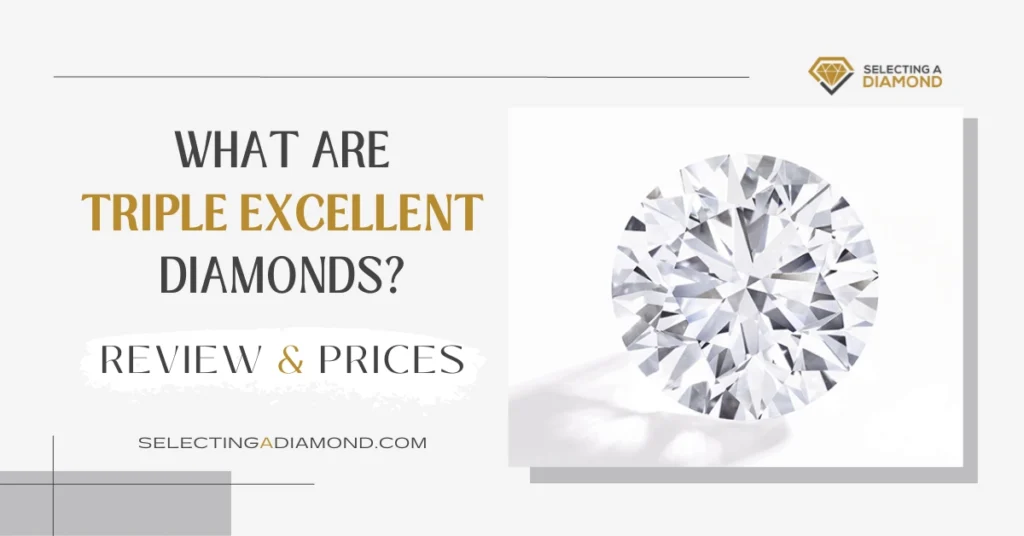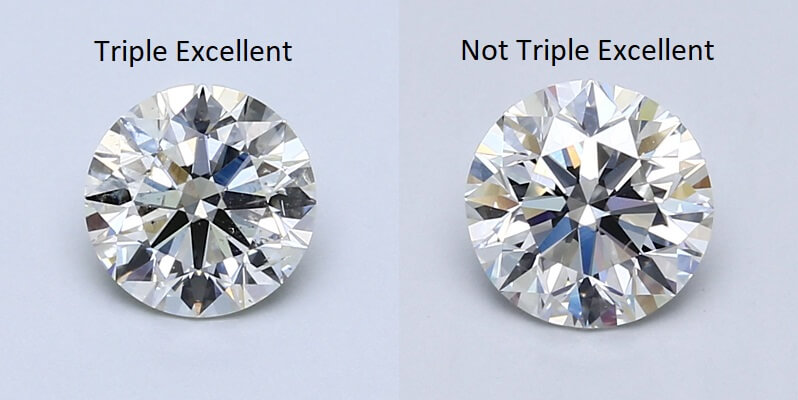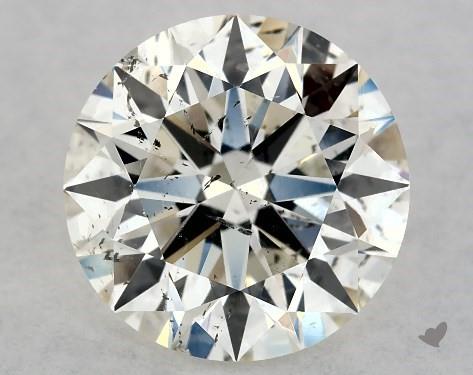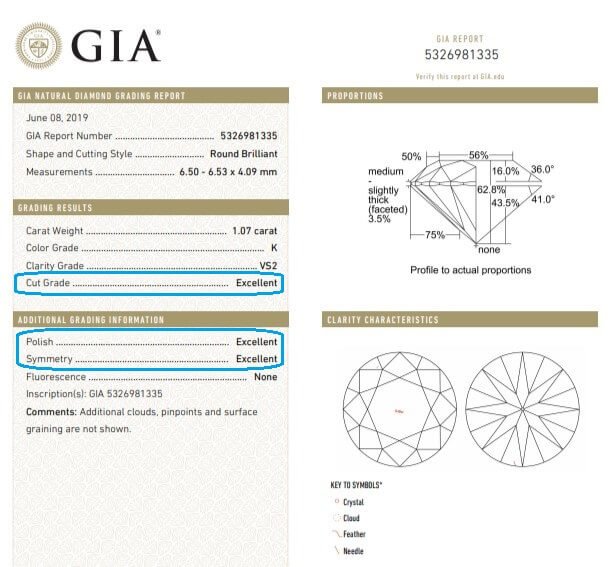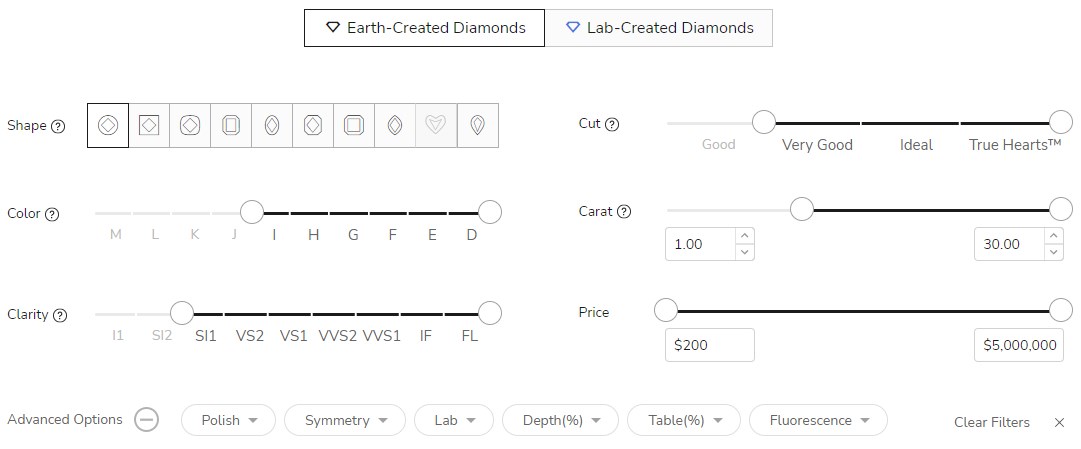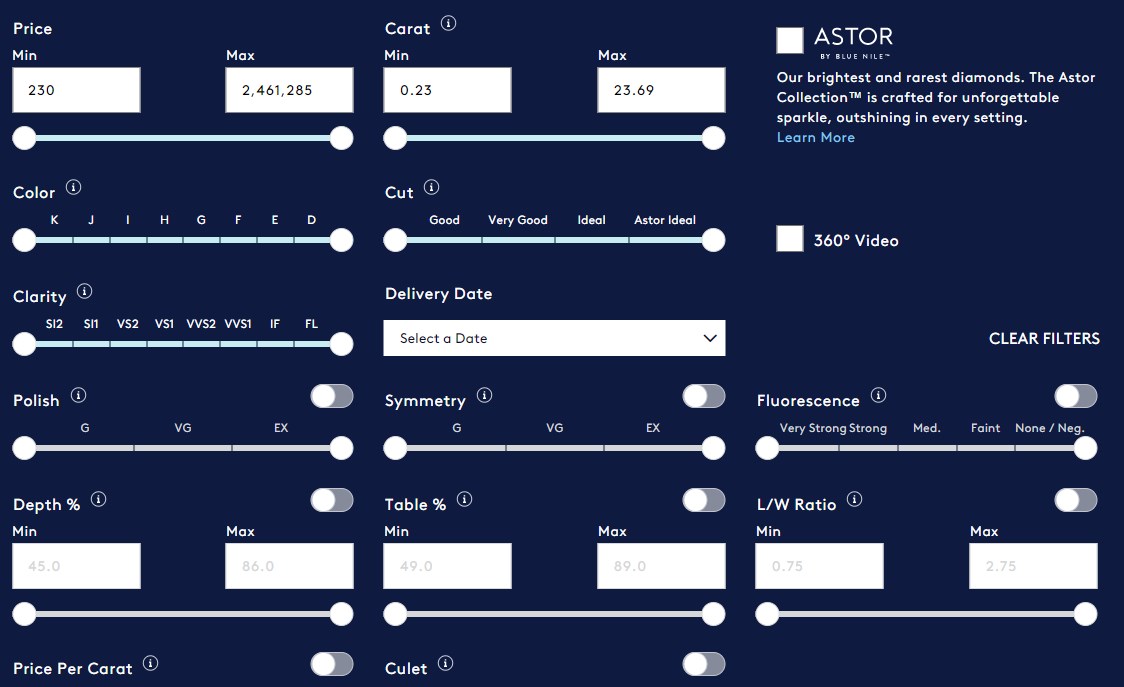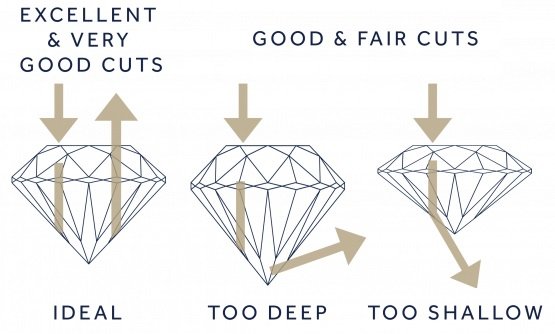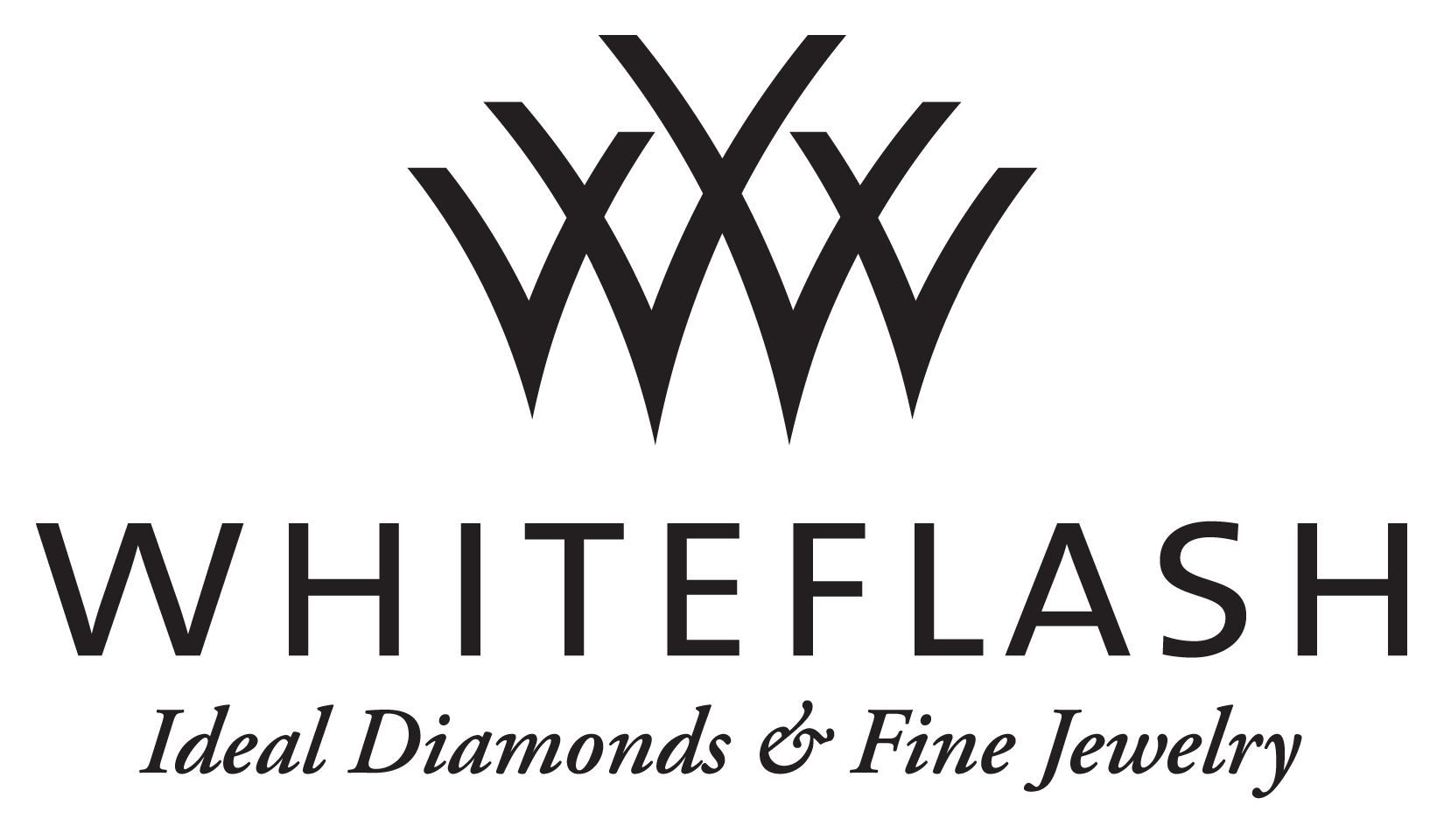Summary in a few lines:
“Triple Excellent,” “GIA XXX,” and “Triple X.” These terms are used again and again in diamond lingo, but what do they really mean? More importantly, what significance do they hold for your diamond purchase?
Here’s a quick spoiler: The Gemological Institute of America (GIA), one of the most respected diamond grading entities globally, does not officially recognize or use these terms to “label” a diamond. However, they’re widely used in the diamond industry.
In plain English, a Triple Excellent diamond refers to a stone with an “Excellent” rating in Cut, Polish, and Symmetry—three critical components of a diamond’s overall appearance and quality.
Now, let’s tackle some of the big questions that might be swirling around in your head:
Does a Triple Excellent rating guarantee a superb diamond? No, it doesn’t.
Can this term be used to inflate the price of a diamond? Absolutely, it can.
Is securing a Triple Excellent diamond necessary to ensure you’re purchasing a high-quality stone? Indeed, it is.
Seems a bit paradoxical, doesn’t it?
Let’s delve a little deeper to unravel the mystery and understand why these seemingly conflicting facts can coexist.
What are Triple Excellent XXX Diamonds?
When a diamond is evaluated by the GIA, they look at a variety of different attributes. This includes the cut, polish, and symmetry of the diamond.
If a diamond is awarded the highest possible grade – “excellent” – for all three of these features, then it might be referred to as a “Triple Excellent” diamond in the market, in a bit more details what this means:
- Excellent Cut: This refers to how well the diamond has been cut from its raw form. Factors such as the diamond’s proportions, facets, and angles come into play here.
- Excellent Polish: Polish describes the smoothness of the diamond’s facets. If there are no polish lines or marks that have been left behind in the cutting process, then the diamond is likely to receive an “excellent” polish grade.
- Excellent Symmetry: This measures the alignment and arrangement of the diamond’s facets. If the facets are perfectly symmetrical, the diamond is likely to receive an “excellent” symmetry grade.
Now, let’s consider a real-world example. Here are two diamond images listed on Blue Nile.
The first one is a “GIA Triple Excellent” diamond, which you can view in 360 here. The second one, although having an Excellent Cut and Polish, falls short with Very Good Symmetry, viewable in 360 here.
Given the choice, we’re pretty certain that under normal circumstances, you’d gravitate towards the Triple Excellent diamond.
But here’s where things get interesting. The term “GIA Triple Excellent” is often used more as a marketing strategy by salespeople than a legitimate diamond grading.
Why? Because they use it to either:
- Sell diamonds of questionable value at disproportionately high prices.
- Label a decent diamond as a “GIA XXX” to jack up its price.
Are All Triple Excellent Diamonds Great?
When assessing a diamond’s quality, we often place the greatest importance on its cut. Indeed, a diamond with an excellent cut grade forms the cornerstone of what’s known as a ‘Triple Excellent’ diamond, which also boasts excellent grades in polish and symmetry. But are all Triple Excellent diamonds as perfect as they sound?
The truth is, polish and symmetry grades do not independently contribute significantly to a diamond’s shine or sparkle. In fact, the vast majority of diamonds with an excellent or ideal cut also achieve excellent grades in polish and symmetry.
For instance, a quick search on James Allen or Blue Nile reveals that approximately 85-90% of diamonds with excellent cut grades also have excellent polish and symmetry grades. Essentially, if you’re investing in a diamond with an ideal cut, it’s almost standard to receive a Triple Excellent diamond.
Behind the Sparkle of Triple Excellent Diamonds
Now, this might make you think that a Triple Excellent diamond guarantees unrivaled sparkle. However, a word of caution is necessary here. A diamond’s brilliance isn’t dictated solely by its cut, polish, and symmetry – there are many other factors at play.
What if the diamond has visible inclusions, or what if it has a low color grade or strong fluorescence?
For example, consider a 2.2 carat diamond with a clarity grade of SI2, but with Triple Excellent grades for cut, polish, and symmetry.
Even if its price seems attractive ($3k as of writing this), would any experienced jeweler recommend it? Keeping in mind that its price is at least 50% of average price per carat.
This underlines an essential truth about diamonds: every single one is unique. They each possess distinct characteristics that contribute to their individual beauty and brilliance.
Here is a pre-set search on James Allen for more than two thousands diamonds that we can NEVER recommend any, and yet, they are all “Triple Excellent diamonds”.
Thus, while the term ‘Triple Excellent’ may seem like a guarantee of a diamond’s quality, remember to look beyond these three grades. Always consider all the other factors that truly make a diamond sparkle.
Does GIA Acknowledge the Term “GIA Triple Excellent – GIA XXX”?
Absolutely not, while the Gemological Institute of America (GIA) is globally recognized for diamond grading, they’ve never officially used terms like “Triple Excellent” or “GIA XXX” to label diamonds. These terminologies are not part of their grading reports or educational posts on their website.
However, in light of the widespread use of such terms in the diamond market, GIA has recently addressed this in an article. They confirmed what we’ve discussed here: the “Triple Excellent” label is more of a marketing ploy than an official diamond grading. GIA has clearly stated that they do not endorse the use of these terms to label a diamond or justify its higher price.
This is an example of a GIA certificate that shows an Excellent grade next to Cut, Polish, and Symmetry, marketing-speaking, this diamond is triple excellent:
Do you see any mention for the Triple Excellent thing? Exactly…
This highlights the importance of understanding diamond grading and being cautious of potentially misleading marketing terms. When buying a diamond, it’s crucial to focus on its individual qualities and your personal preferences rather than getting swept up in the hype created by certain labels.
Do Reputable Retailors Participate in Promoting GIA XXX Diamonds?
While most major diamond retailers such as James Allen, Blue Nile, and Whiteflash do offer filters for cut, polish, and symmetry grades individually, they may not offer a specific filter for “GIA XXX” or “Triple Excellent” for several reasons.
One of these reasons in not to participate & promote in the hype of Triple Excellent labeling of diamonds, because as we saw above, the term “GIA XXX” or “Triple Excellent” is not an official designation by the GIA or other grading entities but is a term used colloquially in the diamond industry.
Retailers might prefer to stick with the standard grading terminology used by the grading entities.
That being said, customers looking for GIA Triple Excellent diamonds can still easily find them by selecting “Excellent” for cut, polish, and symmetry in the search filters on these website, here is a prefiltered search for Triple Excellent diamonds on James Allen for example.
James Allen:
Blue Nile:
Triple Excellent Diamonds Prices
As we know by now, Triple Excellent refers to 3 factors of any diamond, while diamonds have much more than these 3 to have a price range.
More specifically, opting in for an excellent cut diamond will give you (in 90%+ of cases) a triple excellent diamond, so relying on these triple excellent to predict a price range won’t do much of a help.
However, to provide a reference point, suppose we focus our search on a 1 carat diamond with G color, VS2 clarity, no fluorescence, and Triple Excellent grades for cut, polish, and symmetry On James Allen.
The result is:
We found 170 diamonds, ranging between $4500 and $7000.
This price range is quite in line with the average cost for a well-recommended 1 carat diamond. This is because securing a diamond that fits the recommended 4Cs means a Triple Excellent diamond in most instances.
Are Triple Excellent Diamonds Worth it?
The value of a Triple Excellent diamond can be a tricky matter, as it greatly depends on other crucial factors. The Triple Excellent grade, which denotes excellence in cut, polish, and symmetry, doesn’t necessarily imply a flawless diamond.
Yes, a Triple Excellent diamond can be absolutely worth it when it possesses all recommended characteristics, such as a color grade of at least H, an eye-clean clarity grade, and no strong fluorescence.
However, a Triple Excellent diamond that fails in these other factors, like having visible inclusions or a lower color grade that doesn’t meet your preference, may not be worth your investment.
In essence, if you’re seeking a high-quality diamond, it’s advantageous to look for a Triple Excellent diamond that also excels in other important characteristics such as color, clarity, etc. But remember, this shouldn’t be the other way around. Achieving excellence in cut, polish, and symmetry is essential, but you shouldn’t stop there.
Want to learn how to guarantee a great diamond pick? Let’s delve a bit deeper into these factors to ensure you’re buying the right diamond at the right price.
Diamonds Main Characteristics
When shopping for a diamond, it’s crucial to understand its main characteristics, often referred to as the 4Cs: Cut, Carat, Color, and Clarity.
- Cut: This determines how well-proportioned the diamond is in terms of symmetry and light reflection. Among all factors, the cut is considered the most significant, taking precedence over the others.
- Carat: Also known as Carat Weight, this is the standard unit of measurement for a diamond’s weight. However, remember that a higher carat weight doesn’t necessarily mean a larger size. The diamond’s cut can influence its apparent size (not weight), this image explains how:
- Color: This refers to the level of yellowish tint in a diamond, with grades ranging from D (colorless) to K (faint color).
- Clarity: This grade reflects how internal and external blemishes affect a diamond’s value.
Understanding these factors (and others, like table & depth, fluorescence) can enhance your diamond-buying experience and help you find the perfect gem that aligns with your preferences and budget. Feel free to explore our Diamond Buying Guide to learn more about these aspects
AGS Triple 000 vs GIA Triple Excellent
When choosing a diamond, it’s essential to consider the certifications provided by two renowned laboratories: the American Gem Society (AGS) and the Gemological Institute of America (GIA).
These institutions offer diamond grading scales that cover the 4Cs and other important diamond qualities. The AGS uses a numerical grading scale ranging from 0 to 10, while the GIA generally employs descriptive terms (none, fair, good, excellent) to grade specific attributes.
A “Triple Zero” rating from AGS indicates that the diamond has received a ‘0’—the highest grade on AGS’s scale—for cut grade, polish, and symmetry. The AGS’s cut grade is particularly detailed, factoring in aspects such as light performance and proportionality.
Interestingly, the term “AGS 000” used to refer to a diamond with D color, Flawless clarity, and Ideal cut. However, since around 2005, the market has started using AGS 000 to denote excellence in Proportion (cut), Polish, and Symmetry, leaving out any reference to color and clarity.
In contrast, for GIA, “Triple Excellent” signifies that a diamond has received an ‘Excellent’ grade—the highest on GIA’s scale—for cut, polish, and symmetry. The GIA’s cut grade primarily assesses how effectively a diamond’s proportions and finishing details reflect light.
In essence, both “GIA Triple Excellent” and “AGS 000” signify excellence in the same three aspects today. However, they should be taken with a grain of caution. Remember, a diamond’s worth isn’t determined solely by its cut, but by a combination of other vital factors as well.
Triple Excellent Diamonds vs Ideal Cut?
You might be scratching your head at this comparison. After all, it seems a bit unusual to pit these two terms against each other. Well, it’s a valid confusion, and the blame can be placed squarely on the shoulders of the marketing wizards who coined the term “Triple Excellent”. They positioned it as though it were an entirely new diamond category, while in reality, we’ve already established what it truly represents.
So, you’re confronted with the choice: should you go for a GIA Triple Excellent diamond or an Ideal cut diamond?
The answer is:
Why not both?
Choosing an Ideal cut diamond often implies that you’re also acquiring a diamond with Excellent polish and symmetry. This essentially means that by opting for an Ideal cut, you’re inadvertently scoring a Triple Excellent diamond. So, there’s no need for a showdown between these two – they can harmoniously coexist!
Summary: How to Guarantee a Great Sparkling Diamond?
It’s not just about understanding the concept of GIA Triple Excellent – there’s more to securing a brilliantly sparkling diamond. Here are some invaluable tips to ensure you get a diamond that will dazzle for a lifetime.
- Cut is King: Remember, Cut is the most critical factor determining a diamond’s brilliance. Make sure you opt for an ideal cut to guarantee maximum sparkle.
- Color and Clarity: Once you’ve got the cut sorted, the next step is to consider color and clarity. We recommend not going beyond H or G color for the best value for your money. In terms of clarity, aim for an eye-clean diamond, which is usually around the SI1 grade for diamonds around 1 carat, although you may need to opt for a VS2 for larger diamonds.
- View Before Buying: When buying online from vendors like James Allen or Blue Nile, leverage their advanced imaging technologies to view a magnified image of your chosen diamond, ensuring its quality.
- Consider Luxury Options: If you’re in the market for an ultra-luxurious diamond, we suggest you read our expert review of Whiteflash. You’ll gain a thorough understanding of their standing in the diamond industry and when it’s best to purchase from their collection.
- Trustworthy Certificates: Stick with GIA-certified diamonds. GIA is globally recognized as the best diamond certification lab, followed closely by AGS. And avoid EGL-certified diamonds at all costs!
- Polish and Symmetry: Lastly, when it comes to polish and symmetry, securing excellent grades is usually not a challenge.
Remember, the key to a spectacular diamond lies in a balanced consideration of all these factors.
Happy diamond hunting.
Still not sure where to buy your diamond?
We always recommend shopping diamonds online and created a Full guide to shop diamonds like a Pro.
Among online retailers, here are our favorite stores click their logo to visit store
-
James Allen:
Our favorite online store, best diamond imaging technology available today, comes with the largest collection with more than half a million loose diamonds.
-
Blue Nile:
Widest collection of loose diamonds of all sizes, great imaging technology for most of their inventory (hundreds of thousands of diamonds), great customer support.
-
Whiteflash:
Home Of A CUT ABOVE® Super Ideal Diamonds, they stand out from the crowd by offering premium diamonds cuts, tailored to those who love the details, at great prices too.

